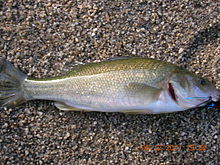Bass is a generic common name shared by many species of ray-finned fish from the large clade Percomorpha, mainly belonging to the orders Perciformes and Moroniformes, encompassing both freshwater and marine species. The word bass comes from Middle English bars, meaning "perch", despite that none of the commonly referred bass species belong to the perch family Percidae.

The Murray cod is a large Australian predatory freshwater fish of the genus Maccullochella in the family Percichthyidae. Although the species is called a cod in the vernacular, it is not related to the Northern Hemisphere marine cod (Gadus) species. The Murray cod is an important part of Australia's vertebrate wildlife—as an apex predator in the Murray-Darling River system—and also significant in Australia's human culture. The Murray cod is the largest exclusively freshwater fish in Australia, and one of the largest in the world. Other common names for Murray cod include cod, greenfish, goodoo, Mary River cod, Murray perch, ponde, pondi and Queensland freshwater cod.
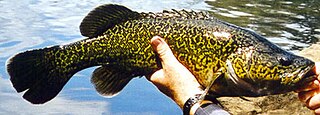
The eastern freshwater cod, also known as the eastern cod or Clarence River cod, is a large predatory freshwater fish of the genus Maccullochella and the family Percichthyidae, that occur in the coastal Clarence River system of north-eastern New South Wales. Eastern freshwater cod are closely related to the Murray cod of the Murray-Darling River system, and are considered an icon of the Clarence River system.
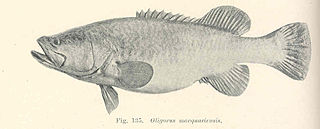
The trout cod or bluenose cod, is a large predatory freshwater fish of the genus Maccullochella and the family Percichthyidae, closely related to the Murray cod. It was originally widespread in the south-east corner of the Murray-Darling river system in Australia, but is now an endangered species.

The Macquarie perch is an Australian native freshwater fish of the Murray-Darling river system. It is a member of the family Percichthyidae and is closely related to the golden perch.

The golden perch is a medium-sized, yellow or gold-coloured species of Australian freshwater fish found primarily in the Murray-Darling River system, though a subspecies is found in the Lake Eyre-Cooper Creek system, and another subspecies, suspected to be ancestral to all other populations, is found in the Fitzroy River system in Queensland. Other common names for golden perch are "goldens", “yellowbelly” and "callop", the last generally used only in South Australia.
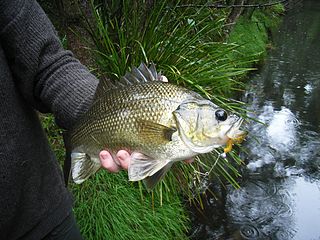
The Australian bass is a small- to medium-sized species of primarily freshwater fish found in coastal rivers and streams along the east coast of Australia. A member of the genus Macquaria from the family Percichthyidae, the Australian bass is an important member of the native fish assemblages found in east coast river systems. It is a native predatory fish and an extremely popular game fish species among anglers. The species was simply called perch in most coastal rivers where it was caught until the 1960s, when the name "Australian bass" started to gain popularity.

The river blackfish is a freshwater fish endemic to the temperate waters of south-eastern Australia. It is found from southern Queensland through to central Victoria, including in the Murray-Darling river system. It is also found in some eastern and southern flowing coastal rivers. Found primarily in upland and "midland" habitats, though early records of fish fauna suggest it was originally far more extensively distributed and was found in some lowland habitats as well. Originally, river blackfish co-inhabited many of its lowland and "midland" habitats with species such as Murray cod and golden perch, and its upland habitats with species such as trout cod and Macquarie perch. It is a popular angling fish in some parts of its range.
The Mary River cod is a species of temperate perch native to the coastal Mary River system of southern Queensland, Australia. Mary River cod are one of Australia's most endangered freshwater fishes and are notable for being the most northerly of the four Maccullochella cods found or once found in coastal river systems of eastern Australia.
The Richmond River cod was a form of Maccullochella cod, now believed to have been eastern freshwater cod, Maccullochella ikei, that occurred naturally in the Richmond River system, an east coast river system in north-east New South Wales, Australia.
The Brisbane River cod was a unique form of Maccullochella cod that occurred naturally in the Brisbane River system, an east coast river system in south east Queensland, Australia. The Brisbane River Cod was known as the Bumgur by the Jinibara people centred in the Kilcoy region and the junction of the Stanley and Brisbane Rivers. Their exact taxonomic status is not known, but based on several genetic studies it is suspected that Brisbane River Cod were a species intermediate between eastern freshwater cod of the Clarence River and Richmond River systems in northern New South Wales and Mary River cod of the Mary River in central Queensland.

Maccullochella is a genus of large Australian predatory freshwater fish within the family Percichthyidae. The genus Maccullochella was named after an early Australian fish researcher with the surname McCulloch.
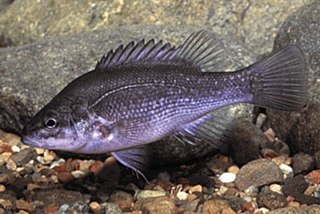
The Bloomfield River cod or the tropical nightfish, is a species of temperate perch endemic to Australia. It is only found in an 11-km stretch of the Bloomfield River in northern Queensland. These waterfalls appear to have blocked the migration of more aggressive tropical freshwater fish species such as the sooty grunter that have presumably naturally displaced the Bloomfield River cod from its former range in prehistoric times. With its very limited distribution, the Bloomfield River cod is clearly a relict species. It is a very important relict species, however, as it is the most northerly distributed percichthyid species in Australia and raises interesting questions on the biogeography of percichthyid fish in Australia and the history of their ancient colonisation of Australian rivers.

Macquaria is a genus of medium-sized, predatory temperate perches endemic to Australia. They are found in rivers and estuaries of the eastern part of the continent.

Gadopsis is a genus of temperate perches endemic to freshwater habitats in southeastern Australia. The genus was formerly considered to be in a family of its own, Gadopsidae.
Nannoperca or pygmy perch is a genus of temperate perches endemic to freshwater systems of Australia.

Percichthys is a genus of temperate perches native to freshwater habitats in Argentina and Chile.
Scottsdale Reserve is a 1,328-hectare (3,280-acre) nature reserve on the Murrumbidgee River in south-central New South Wales, Australia. It is 79 kilometres (49 mi) south of Canberra, and 4 kilometres (2.5 mi) north of Bredbo. It is owned and managed by Bush Heritage Australia (BHA), which purchased it in 2006. The purchase was supportive of projects aiming to connect existing fragmented remnant habitat such as K2C. Since the 1870s up until 2006, the land was used for agriculture – primarily sheep grazing with some minor cropping. A significant component of the Reserve has been cleared of native vegetation.
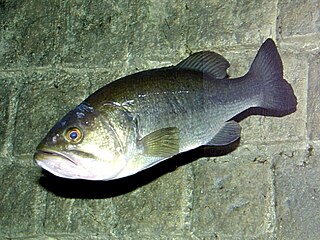
Centrarchiformes is an order of ray-finned fish, previously included amongst the perciformes, with 21 families. This order first appeared about 55.8 million years ago in the Eocene Era, and is composed primarily of omnivores. The order has a wide range that includes the continents of Australia and South America. Many Centrarchiformes look essentially perch-like, featuring a stocky build and a spine-bearing dorsal fin, and range in size from 2.5 cm in length, to 1.8 meters for the Maccullochella peelii. The order Centrachiformes is not recognized in the 5th Edition (2016) of Fishes of the World, but is accepted on the World Register of Marine Species in November 2023.
